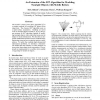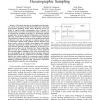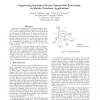717 search results - page 22 / 144 » Autonomous mobility skeletons |
IJCAI
2003
13 years 9 months ago
2003
The iterative closest point (ICP) algorithm [2] is a popular method for modeling 3D objects from range data. The classical ICP algorithm rests on a rigid surface assumption. Build...
ICRA
2007
IEEE
14 years 1 months ago
2007
IEEE
Abstract— This paper describes an investigation into the adaptive control of autonomous mobile sensor platforms for providing oceanographic sampling. Mobile sensor platforms prov...
SRDS
1995
IEEE
13 years 11 months ago
1995
IEEE
Advances in computer and telecommunication technologies have made mobile computing a reality. However, greater mobility implies a more tenuous network connection and a higher rate...
IROS
2006
IEEE
14 years 1 months ago
2006
IEEE
– Many untethered mobile robots require an operator’s vision and intelligence for guidance and navigation. Animals and insects, however, use sensory systems such as hearing, an...
ICSE
2007
IEEE-ACM
14 years 7 months ago
2007
IEEE-ACM
In the mid-nineties, mobile code was on the rise and, in particular, there was a growing interest in autonomously moving code components, called mobile agents. In 1997, we publish...



